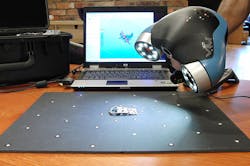The market for 3D scanners is projected to increase by a factor of four over the period from 2020 to 2030, according to recent marketing study Future Market Insights. This means the market for the scanners would grow at an annual rate of 14% over that decade. This growth is being fueled by a wide variety of industries adopting and customizing 3D scanning for their own purposes and for commercial use.
For example, in the healthcare sector, 3D scanners gather data from a patient’s own organs and tissues to model body organs in three dimensions. These are then used to create custom fit prosthetics, implants, and supports and bandages. The models can also be used to facilitate wound management and form body implants.
This growth also comes in spite of the drag created by the COVID-19 pandemic, which has taken a serious bite out of the profit margins of electronics manufacturers globally. This, in turn, has created weeks of delays for 3D scanners companies due to raw-material shortages. Furthermore, manufacturing and automotive industries are key markets for 3D scanners, and the pandemic has severely affected those two industries. A majority of manufacturers are forecasting a decline in sales over the first two quarters of 2020, but more than 60% are projecting business operations to recover by October of this year.
3D scanners/hardware will continue to hold leading market share over the following decade due to several factors:
- Among all engineering services, 3D design and modelling are expected to expand at the highest CAGR over the coming years.
- Market players continue to capitalize on portable/handheld 3D scanners, while robot-mount 3D scanners offer potential value-capture opportunities.
- Short range (less than 3 ft) 3D scanners will capture a prominent revenue share; long range (more than 900 ft) 3D scanners will see an upsurge in later years.
- Healthcare and manufacturing industries will remain the key end users of 3D scanners, with manufacturing showing the most worthwhile prospects in the near term.
- Increasing use of 3D scanners in collision detection will boost their market share in the auto industry.
3D scanners are used in collision avoidance as well as in vehicle navigation. These scanners come with features such as highly accurate measurements and documentation, making them useful for collision detection/avoidance and accident reconstruction. Furthermore, handheld 3D scanners will be more widely used to record the interiors of damaged vehicles, letting that damage be recorded, measured and analyzed. The move to more autonomous vehicles will also make onboard 3D scanners important for mapping highways and the surroundings.

